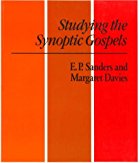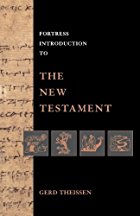Part 1: A Sea Change
Published in 1989 by SCM Press, Studying the Synoptic Gospels remains one of the best resources for learning about the first three books of the New Testament. Not a week goes by that I don’t take it off the shelf and refer to it. Sanders and Davies cover most of the important subjects related to synoptic studies, and they do it in an engaging and evenhanded manner. Each subject receives appropriate coverage, with suggested “further readings” that can take you even deeper.

Studying the Synoptic Gospels treats the question of genre quite seriously, devoting one chapter for each gospel. The chapter on Matthew for example, continues for 14 pages, touching on its various features — how it resembles different forms of known, contemporaneous literature, how it uses the traditional material, etc. In the end, the authors conclude:
The most satisfactory definition of the genre is ‘a theodicy about the creation and recreation (see palingenesia, ‘new world’, 19.28) which is centered in the life, death and resurrection of Jesus.’ (p. 264, italics original)
The authors contend that although in some ways Matthew’s gospel resembles a βίος (bios), it also has some striking differences, and in the end, it is a wholly inadequate description. Mark has even less in common with ancient literary biographies. They write:
The form of the Second Gospel is, however, even less like a Hellenistic biography than that of Matthew. It does not begin with birth stories, and, if 16.8 is the original ending, it is quite without parallel. (p. 267, bold original)
The authors grant that Luke has even more in common with Hellenistic biographies than the first two gospels.
It is fair to say that Luke-Acts could not have existed in its present form without knowledge of Graeco-Roman texts. . . . But, to return to the preface, the truth for which the work offers Theophilus assurance is not just the accurate reporting of past events, nor the discernment of patterns of history, nor the exact depiction of a holy community worthy of imitation or admiration, but the story of the creator God who repeatedly offers people salvation, through prophets, through Jesus and through his apostles, and whose sovereignty is about to be finally established by replacing the kingdom of Satan on earth with that of God. Historical motifs are swallowed up by eschatological, and history is understood from the perspective of creation and recreation. (p. 297, emphasis added)
Ultimately, the problem with identifying the genre of the synoptic gospels as Hellenistic biographies or Graeco-Roman histories is that these terms are insufficient to describe their form, genesis, and purpose.

Now compare Sanders’ and Davies’ careful, detailed, and sober conclusions to this quote from the Fortress Introduction to the New Testament by Gerd Theissen:
The gospel is a variant of the ancient ‘life’, which was widespread in the non-Jewish world: the gospel is an ancient bios (a better term to use than ‘biography’), though a bios of an unusual kind. (p. 16, Nook edition, 2004, bold and color emphasis added)
Theissen notes that writings centered on a single person were quite unknown in the Old Testament. How did a sect that started within Judaism come to employ a genre that was so unlike anything known in Jewish religious writings up to that point? He says: Continue reading “The Genre of the Gospels: How the Consensus Changed (Part 1)”
